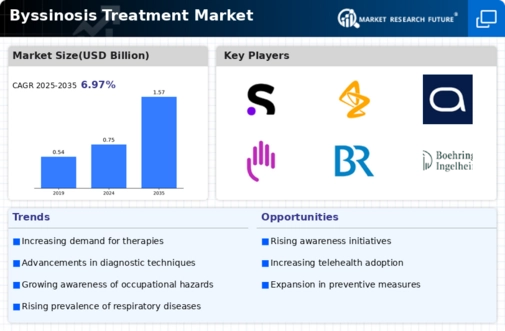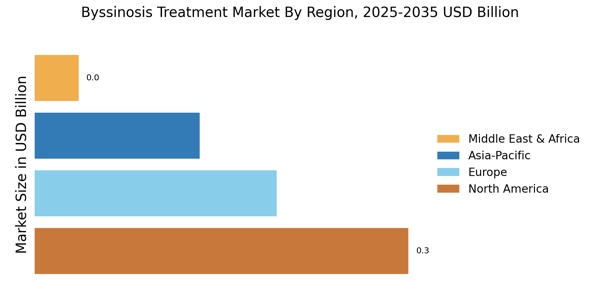Growing Incidence of Respiratory Diseases
The growing incidence of respiratory diseases, particularly in industrial sectors, is a significant driver for the Byssinosis Treatment Market. As more individuals are diagnosed with byssinosis, the demand for effective treatment solutions is likely to increase. Epidemiological studies have shown a correlation between prolonged exposure to cotton dust and the development of respiratory conditions, which has raised concerns among health authorities. This trend is prompting healthcare providers to enhance their treatment offerings and invest in research for new therapies. Market analysis indicates that the rising number of cases could lead to a substantial increase in treatment expenditures, thereby expanding the market. The focus on addressing respiratory diseases is expected to remain a priority for both public health officials and the pharmaceutical industry.
Government Regulations and Health Policies
Government regulations and health policies play a crucial role in shaping the Byssinosis Treatment Market. Many countries are implementing stricter occupational health standards to protect workers from exposure to harmful substances, including cotton dust. These regulations often mandate regular health screenings and the provision of treatment for affected individuals. As a result, healthcare systems are compelled to allocate resources towards the diagnosis and treatment of byssinosis. Data from health organizations indicate that compliance with these regulations is leading to an increase in the number of patients seeking treatment, thereby driving market growth. The emphasis on preventive measures and early intervention further underscores the importance of effective treatment options in the industry.
Rising Awareness of Occupational Health Risks
The increasing awareness of occupational health risks associated with byssinosis is a pivotal driver for the Byssinosis Treatment Market. As industries such as textiles and agriculture continue to expand, the recognition of respiratory diseases linked to cotton dust exposure has grown. This heightened awareness has led to more stringent regulations and guidelines aimed at protecting workers. Consequently, healthcare providers are more likely to invest in treatment options for affected individuals. Reports indicate that the prevalence of byssinosis is notably higher in certain regions, prompting local governments to implement health programs. This trend suggests a growing market for effective treatments, as both employers and employees seek solutions to mitigate health risks and improve workplace safety.
Increased Investment in Research and Development
Increased investment in research and development is driving innovation within the Byssinosis Treatment Market. Pharmaceutical companies and research institutions are allocating significant resources to explore new treatment options and improve existing therapies for byssinosis. This investment is often fueled by the need to address the unmet medical needs of patients suffering from this condition. Collaborative efforts between academia and industry are also fostering advancements in treatment methodologies. Data suggests that the market for byssinosis treatments could expand as new therapies emerge from ongoing research initiatives. The emphasis on developing effective and safe treatment options is likely to enhance patient outcomes and drive market growth in the coming years.
Technological Innovations in Treatment Modalities
Technological advancements in treatment modalities are significantly influencing the Byssinosis Treatment Market. Innovations such as targeted therapies and improved inhalation devices are enhancing the efficacy of treatments for byssinosis. For instance, the development of new bronchodilators and corticosteroids has shown promise in alleviating symptoms and improving lung function in affected patients. Furthermore, the integration of telemedicine in treatment protocols allows for better patient monitoring and management, particularly in remote areas. Market data suggests that the demand for advanced treatment options is on the rise, as patients seek more effective and convenient solutions. This trend indicates a potential shift in the market landscape, with an increasing focus on personalized medicine and patient-centered care.


















Leave a Comment